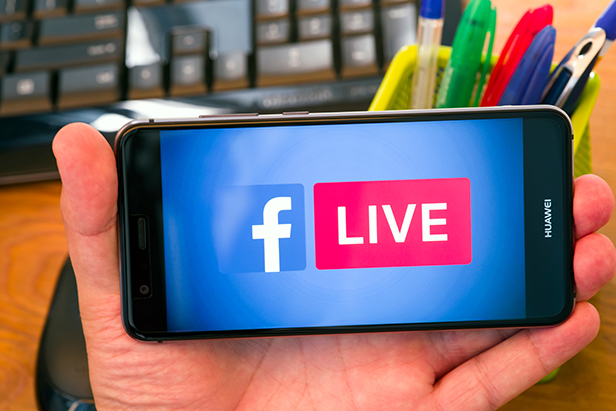Strategy August 26, 2020
How to Optimize Facebook Live Broadcasts
The strategies come directly from a recently debuted tips video from Facebook.
Facebook has released a new video with tips for how to maximize the success of your Facebook Live broadcasts.
It’s a timely release. Use of the Live format has increased during the COVID-19 pandemic. “We’ve seen tremendous growth in Live usage over the last few months,” says Colyn Montgomery, a product manager for Facebook Live.
Montgomery notes that churches streaming their Sunday services, small businesses using the platform for marketing and retail efforts, and musical acts/comedians doing shows are among those helping to drive the increase in Live usage.
The rising use of Live appears to be warranted. Live videos generally receive better engagement than premade video uploads. And, live stream views are up about 50% since January.
Live, of course, is just what its name implies: A live broadcast on your Facebook page. In the above tips video from Facebook, Montgomery provided Live strategies that include:
Take care of the technical: Make sure you have a good, functioning camera that provides a clear picture. Ensure your audio is good. And most importantly, operate from a strong internet connection that will allow for smooth, uninterrupted streaming. If you’re working from home, getting the latter element correct could include asking other users who might be on the Wi-Fi to shut down until your broadcast concludes. “A good stable internet connection is huge,” says Montgomery. Lack of such a connection is “the most common point of failure” in Live broadcasts, he says.

Have a clear plan for each broadcast: Admittedly, this isn’t always possible, such as times where you might be filming spontaneously. Still, with many Lives that aim to inform and entertain key audiences, while also building your personal/professional brand, there’s opportunity to plan in advance. Montgomery suggests that you know your intended audience, exactly what you want to communicate and the creative means by which you’ll achieve that communication/objective. If you’ll need props or other such elements, make sure to have them at the ready. And, in general, try to keep your background uncluttered; cluttered backgrounds can be distracting.
Promote in advance: Montgomery advises that you use Facebook’s Live Producer to schedule a Live broadcast. It will publish an announcement to Facebook that allows people to RSVP, which enables them to receive reminders about the upcoming Live. Also, promote the pending Live through other social platforms you may be active on, such as Twitter, LinkedIn and Instagram. While Montgomery didn’t specifically mention this, you can also inform audiences about the coming Live through newsletters you may already routinely put out, as well as by directly reaching out to clients, prospects and colleagues that you think would be interested in the content.
Be sure to Cross-post when possible: Users should take advantage of “cross-posting,” says Montgomery. This involves posting to another Facebook page you might control and/or the page of a guest you may be hosting on the Live. This helps expand your reach. Cross-posting “allows you to post simultaneously to multiple pages at once, and it looks like a native video to that page, but the viewership is all aggregated, the statistics all aggregated on that one video asset,” Montgomery says.
Engage with audiences: During your Live, verbally encourage feedback/comments from audiences throughout the video. Get the ball rolling by posting the first comment in the comments sections; that could help compel others past their shyness and help get them to give feedback. Do your best to respond to questions and comments that come in – either verbally during the video and/or through written replies. Montgomery suggests that you moderate comments in order to keep the conversation “healthy.” With the right amount of prep, you can also use polls in-stream to drive engagement.
Delve into the analytics to get better: Through tools like Creator Studio, study the performance and type of engagement your Lives receive. Look for things like audience retention and analyze how Lives might be affecting page follower growth, Montgomery says. Use stat analysis to help determine if your Lives are too short or too long. Also, look at how long it takes for your audience to start tuning into and engaging with your Lives. If, for example, viewership tends to be sparse at the start, then plan to build in a little lead-up discussion before digging into the main topic, Montgomery advises.
Don’t use copyrighted music: Montgomery notes that Lives can be paused, muted or taken down if they feature copyrighted music and the person/company broadcasting the video doesn’t have permission to use that music.
